【推荐】初中英语语法说课稿word版本 (7页)
- 格式:docx
- 大小:20.33 KB
- 文档页数:8
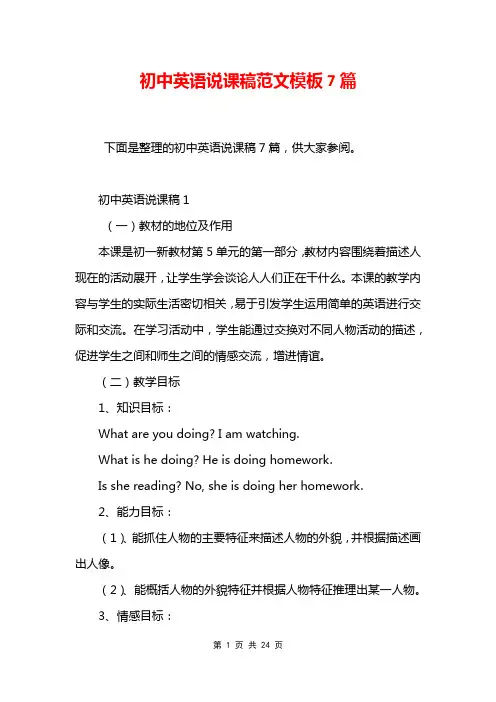
初中英语说课稿范文模板7篇下面是整理的初中英语说课稿7篇,供大家参阅。
初中英语说课稿1(一)教材的地位及作用本课是初一新教材第5单元的第一部分,教材内容围绕着描述人现在的活动展开,让学生学会谈论人人们正在干什么。
本课的教学内容与学生的实际生活密切相关,易于引发学生运用简单的英语进行交际和交流。
在学习活动中,学生能通过交换对不同人物活动的描述,促进学生之间和师生之间的情感交流,增进情谊。
(二)教学目标1、知识目标:What are you doing? I am watching.What is he doing? He is doing homework.Is she reading? No, she is doing her homework.2、能力目标:(1)、能抓住人物的主要特征来描述人物的外貌,并根据描述画出人像。
(2)、能概括人物的外貌特征并根据人物特征推理出某一人物。
3、情感目标:通过描述同学、教师或自己的偶像的外貌,表达自己的看法,使学生在人际交往中学会尊重和理解别人,学会交换不同的看法,了解他人的爱好,增进情谊。
(三)教学重点及难点1、掌握并运用描述人物活动和地点的词汇:watching, doing, eating cleaning, playing, reading, swimming, shopping, pool, school, mall, library2、掌握并运用简单的英语交际句型:What are you doing? I am watching.What is he doing? He is doing homework.Is she reading? No, she is doing her homework.(四)。
教法设计对本课我主要采取了如下几种教法:1.听录音。
听音是英语学习的重要方法,也是课堂教学的重要步骤。
在听中可以感知,可以模仿。
2.重点解释,个别操练。


初中英语语法说课稿子一、教学目标1. 知识与技能目标:使学生掌握一般现在时、一般过去时和一般将来时的用法,能够正确使用这些时态描述日常活动和事件。
2. 过程与方法目标:通过实际对话和练习,培养学生的语法分析能力和语言运用能力。
3. 情感态度与价值观目标:激发学生学习英语的兴趣,培养他们对英语语法的重视,以及正确使用英语进行交流的意识。
二、教学重点1. 一般现在时的构成和用法。
2. 一般过去时的构成和用法。
3. 一般将来时的构成和用法。
三、教学难点1. 不同时态的动词形式变化。
2. 时态在语境中的恰当运用。
四、教学方法1. 启发式教学:通过提问引导学生思考,激发他们的学习兴趣。
2. 任务型教学:设计实际的交流任务,让学生在完成任务的过程中学习和运用语法。
3. 合作学习:鼓励学生小组合作,共同探讨和解决问题。
五、教学过程1. 导入(Lead-in):通过展示不同时间的活动图片,引出时态的概念。
2. 新课呈现(Presentation):逐一介绍三种时态的构成和基本用法。
3. 练习(Practice):设计填空、转换句型等练习,巩固学生对时态的理解。
4. 应用(Application):通过角色扮演、情景对话等活动,让学生实际运用所学时态。
5. 总结(Summary):回顾本课所学内容,强调时态的正确使用。
6. 作业(Homework):布置相关的语法练习和写作任务,加深学生对时态的掌握。
六、教学媒体与教具1. 多媒体课件:展示时态的构成和例句。
2. 黑板:用于板书重点内容和练习题。
3. 卡片:用于角色扮演和情景对话活动。
七、板书设计- 一般现在时:构成 + 用法 + 例句- 一般过去时:构成 + 用法 + 例句- 一般将来时:构成 + 用法 + 例句八、教学反思课后,教师应根据学生的表现和作业完成情况,反思教学方法和内容,不断调整和优化教学策略,以提高教学效果。
通过这份说课稿,教师可以系统地准备和实施英语语法教学,确保学生能够全面理解和掌握英语时态的相关知识。

初中英语语法焦点说课稿初中英语语法是英语学习的基础,它涵盖了词汇、句型、时态等多个方面。
本节课,我们将重点讲解英语语法中的几个关键点,帮助同学们更好地理解和运用英语语法。
首先,我们来看名词的单复数形式。
名词是表示人、地方、事物或概念的词。
在英语中,名词有单数和复数之分。
单数形式通常用于指代一个,而复数形式用于指代多个。
例如,"apple"是单数形式,表示一个苹果,而"apples"则是复数形式,表示多个苹果。
在变复数时,有些名词只需在词尾加上"-s",如"cat"变为"cats";有些则需要加上"-es",如"box"变为"boxes"。
接下来,我们讨论动词的时态。
时态是表示动作或状态发生时间的方式。
英语中有多种时态,包括一般现在时、一般过去时、一般将来时等。
例如,一般现在时用来描述经常发生的动作或状态,如"I play basketball every weekend.";一般过去时用来描述过去发生的动作或状态,如"I played basketball yesterday.";一般将来时则用来描述将来要发生的动作或状态,如"I will play basketball tomorrow."此外,我们还将学习形容词和副词的比较级和最高级形式。
形容词用来描述名词,而副词则用来描述动词、形容词或其他副词。
比较级用于比较两个事物,如"He is taller than me.";最高级用于比较三个或三个以上的事物,如"He is the tallest in the class."最后,我们要注意句子结构。
英语句子通常遵循主语+谓语+宾语(SVO)的结构。
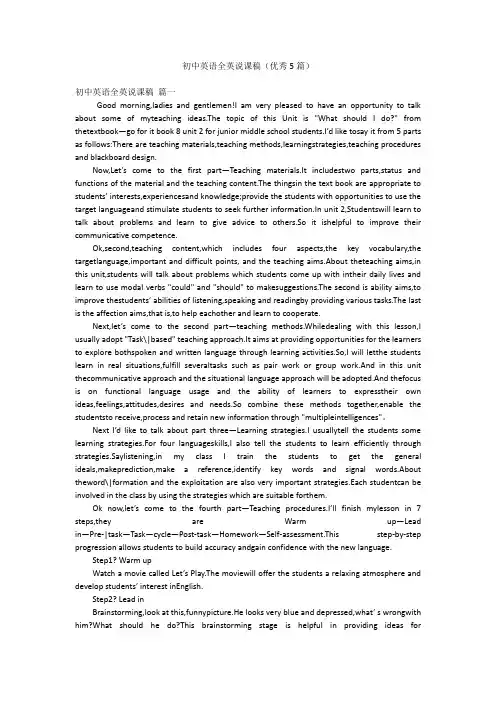
初中英语全英说课稿(优秀5篇)初中英语全英说课稿篇一Good morning,ladies and gentlemen!I am very pleased to have an opportunity to talk about some of myteaching ideas.The topic of this Unit is "What should I do?" from thetextbook—go for it book 8 unit 2 for junior middle school students.I’d like tosay it from 5 parts as follows:There are teaching materials,teaching methods,learningstrategies,teaching procedures and blackboard design.Now,Let’s come to the first part—Teaching materials.It includestwo parts,status and functions of the material and the teaching content.The thingsin the text book are appropriate to students’ interests,experiencesand knowledge;provide the students with opportunities to use the target languageand stimulate students to seek further information.In unit 2,Studentswill learn to talk about problems and learn to give advice to others.So it ishelpful to improve their communicative competence.Ok,second,teaching content,which includes four aspects,the key vocabulary,the targetlanguage,important and difficult points, and the teaching aims.About theteaching aims,in this unit,students will talk about problems which students come up with intheir daily lives and learn to use modal verbs "could" and "should" to makesuggestions.The second is ability aims,to improve thestudents’ abilities of listening,speaking and readingby providing various tasks.The last is the affection aims,that is,to help eachother and learn to cooperate.Next,let’s come to the second part—teaching methods.Whiledealing with this lesson,I usually adopt "Task\|based" teaching approach.It aims at providing opportunities for the learners to explore bothspoken and written language through learning activities.So,I will letthe students learn in real situations,fulfill severaltasks such as pair work or group work.And in this unit thecommunicative approach and the situational language approach will be adopted.And thefocus is on functional language usage and the ability of learners to expresstheir own ideas,feelings,attitudes,desires and needs.So combine these methods together,enable the studentsto receive,process and retain new information through "multipleintelligences"。

初二英语语法说课稿模板尊敬的同事们,今天我将为大家展示一堂初二英语语法课的说课稿模板。
这堂课的主题是“一般过去时态的构成与应用”。
一、教学目标1. 知识与技能:学生能够掌握一般过去时态的基本构成,理解其在句子中的作用。
2. 过程与方法:通过实例分析和练习,学生能够正确使用一般过去时态描述过去发生的动作或状态。
3. 情感态度与价值观:激发学生对英语学习的兴趣,培养他们使用英语进行交流的能力。
二、教学重点1. 一般过去时态的构成规则。
2. 不规则动词的过去式形式。
三、教学难点1. 不规则动词的过去式记忆。
2. 一般过去时态在不同语境下的正确应用。
四、教学方法1. 讲授法:对一般过去时态的构成进行系统讲解。
2. 互动法:通过小组讨论和角色扮演,让学生在实际语境中运用一般过去时态。
3. 练习法:通过填空、改错等练习,巩固学生对一般过去时态的掌握。
五、教学过程1. 导入(5分钟)- 通过提问学生昨天的活动,自然引入一般过去时态的概念。
2. 新课呈现(15分钟)- 讲解一般过去时态的定义和构成,展示规则动词的过去式变化规则。
- 举例说明不规则动词的过去式,如go-went, eat-ate等。
3. 练习巩固(15分钟)- 分发练习题,让学生独立完成,然后进行小组讨论,共同找出答案。
4. 应用实践(10分钟)- 组织学生进行角色扮演,用一般过去时态描述一个虚构的故事。
5. 课堂小结(5分钟)- 总结一般过去时态的要点,强调不规则动词的重要性。
6. 布置作业(5分钟)- 要求学生写一篇日记,用一般过去时态描述自己的一天。
六、板书设计- 一般过去时态- 定义:表示过去发生的动作或状态- 构成:动词+ed(规则动词)/不规则变化(不规则动词)七、教学反思- 反思学生在课堂上的表现,思考如何更有效地帮助学生掌握一般过去时态。
- 考虑如何调整教学方法,以适应不同学生的学习需求。
通过这堂课,我们希望学生能够不仅理解一般过去时态的语法规则,而且能够在实际交流中灵活运用,提高他们的英语交际能力。
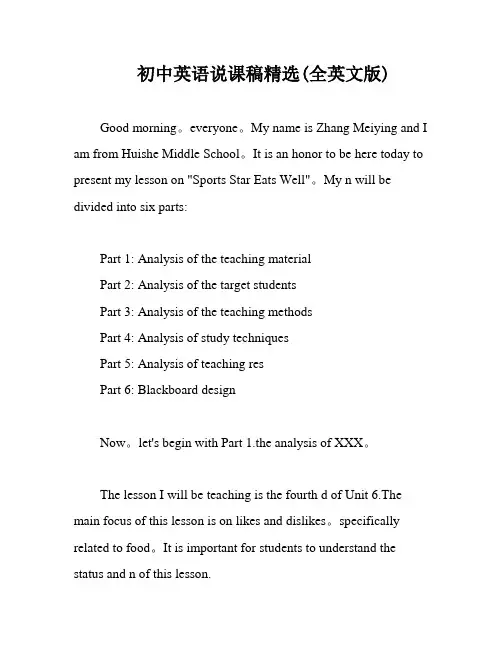
初中英语说课稿精选(全英文版)Good morning。
everyone。
My name is Zhang Meiying and I am from Huishe Middle School。
It is an honor to be here today to present my lesson on "Sports Star Eats Well"。
My n will be divided into six parts:Part 1: Analysis of the teaching materialPart 2: Analysis of the target studentsPart 3: Analysis of the teaching methodsPart 4: Analysis of study techniquesPart 5: Analysis of teaching resPart 6: Blackboard designNow。
let's begin with Part 1.the analysis of XXX。
The lesson I will be teaching is the fourth d of Unit 6.The main focus of this lesson is on likes and dislikes。
specifically related to food。
It is important for students to understand the status and n of this lesson.Teaching aims and demands XXX: knowledge aims。
ability aims。
and nal aims。
The knowledge aims of this lesson are to help students master new XXX "star," "eat," "well," "habit," "healthy," "really," "n," "want," and "fat." nally。
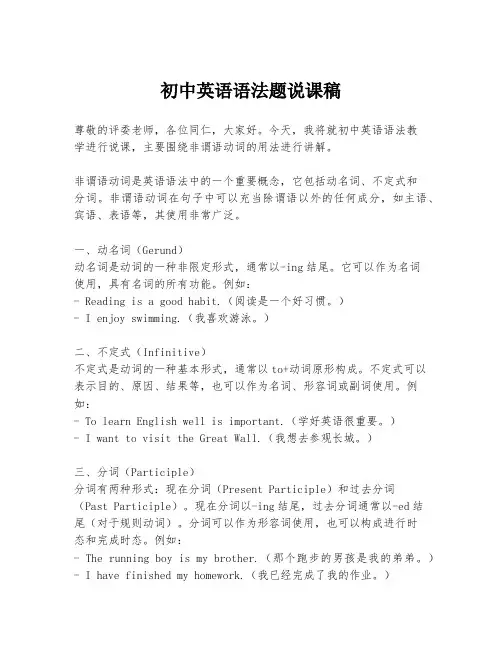
初中英语语法题说课稿尊敬的评委老师,各位同仁,大家好。
今天,我将就初中英语语法教学进行说课,主要围绕非谓语动词的用法进行讲解。
非谓语动词是英语语法中的一个重要概念,它包括动名词、不定式和分词。
非谓语动词在句子中可以充当除谓语以外的任何成分,如主语、宾语、表语等,其使用非常广泛。
一、动名词(Gerund)动名词是动词的一种非限定形式,通常以-ing结尾。
它可以作为名词使用,具有名词的所有功能。
例如:- Reading is a good habit.(阅读是一个好习惯。
)- I enjoy swimming.(我喜欢游泳。
)二、不定式(Infinitive)不定式是动词的一种基本形式,通常以to+动词原形构成。
不定式可以表示目的、原因、结果等,也可以作为名词、形容词或副词使用。
例如:- To learn English well is important.(学好英语很重要。
)- I want to visit the Great Wall.(我想去参观长城。
)三、分词(Participle)分词有两种形式:现在分词(Present Participle)和过去分词(Past Participle)。
现在分词以-ing结尾,过去分词通常以-ed结尾(对于规则动词)。
分词可以作为形容词使用,也可以构成进行时态和完成时态。
例如:- The running boy is my brother.(那个跑步的男孩是我的弟弟。
)- I have finished my homework.(我已经完成了我的作业。
)在教学过程中,我会通过以下几个步骤来引导学生掌握非谓语动词的用法:1. 引入概念:首先,我会向学生介绍非谓语动词的概念和分类,让学生对非谓语动词有一个基本的认识。
2. 举例说明:通过大量的例句,让学生了解非谓语动词在句子中的具体用法和作用。
3. 练习巩固:设计一些练习题,让学生在实际语境中运用非谓语动词,加深理解和记忆。
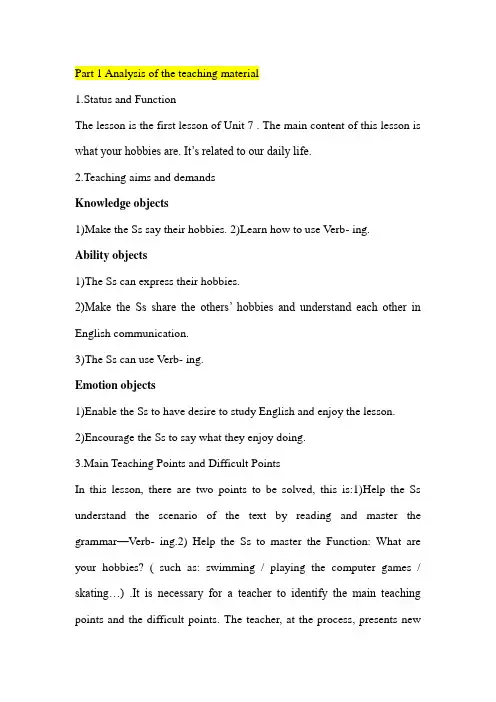
Part 1 Analysis of the teaching material1.Status and FunctionThe lesson is the first lesson of Unit 7 . The main content of this lesson is what your hobbies are. It’s related to our daily life.2.Teaching aims and demandsKnowledge objects1)Make the Ss say their hobbies. 2)Learn how to use Verb- ing.Ability objects1)The Ss can express their hobbies.2)Make the Ss share the others’ hobbies and understand each other in English communication.3)The Ss can use Verb- ing.Emotion objects1)Enable the Ss to have desire to study English and enjoy the lesson.2)Encourage the Ss to say what they enjoy doing.3.Main Teaching Points and Difficult PointsIn this lesson, there are two points to be solved, this is:1)Help the Ss understand the scenario of the text by reading and master the grammar—Verb- ing.2) Help the Ss to master the Function: What are your hobbies? ( such as: swimming / playing the computer games / skating…) .It is necessary for a teacher to identify the main teaching points and the difficult points. The teacher, at the process, presents newlanguage items and explains model skills, lets the Ss have more opportunities to express the new language and use in each activity.4.Teaching aidsblackboard , pictures , tape recorder , multi-media computerPart 2 Analysis of the studentsMost of the students in this class aren’t good at English because their English teacher is often changed. They don’t often use English to express themselves and communicate with others. Some students aren’t active in the clas s, they don’t want to open their mouths because they are afraid of making mistakes.Part 3 Teaching methodsAccording to New Course Standard of English, combining with the language level of Ss, I take Three task-teachings; Communicative methods; Aural-oral methods with the help of the computer.In the teaching process, I will apply blackboard , pictures , tape recorder and multi-media computer to arouse the Ss’ interests in learning.Part 4 Learning StrategiesIn the process of learning , lots of linguistic activities are to be applied. Because the language activity-practice is the only approach for Ss to master either the basic knowledge of English or the language competence.Help the Ss to learn to study independently, learn to cooperate with others.In class, encourage the Ss to communicate with others and build up their confidence.Part 5 Teaching proceduresStep 1 Pre-task1.Listen to the song “You Are You!”(Song is a good way to relax the Ss themselves. By listening to the song , the Ss can receive so me moral education. It’s helpful to teach the lesson.)2.Warming up . (In this period, I’ll show some pictures of hobbies to arouse the Ss’interests.)3.Free talk. Show some pictures and ask. (individual work)a.Do you like writing/reading/……?T: He likes writing. Writing is his hobby.b.Do you have a hobby?c.Would you like to have a hobby?d.What’s your hobby?(It provides a chance for the Ss to improve and practice their speaking skills.)Step 2 While-task1. Introduce the new words on the screen. (class work)hobby guess sell frame wall instruction roll2.Introduce the meaning of “hobby”. (A hobby is just something you like to do in your spare time. It’s fun!)3.Play the tape, while making the Ss answer the questions:a.Where is Danny now?b.What would he like to buy?c.Did he buy a tree? Why?d.What did he buy at last?Step 3 Post-task1.Add –ing after the verbs and discuss the regulars of verb-ing. (group work)skate-skating ; run-running ; read-reading ;listen-listening ; sing-singing动词-ing形式的构成:⑴、一般在动词原形末尾加-ing。

《语法》说课稿范文五篇篇一:语法说课稿教学目标: 1.了解感知动词过去分词做宾语补足语。
2.记忆能在其后加宾补的常用动词。
3.学会使用过去分词做宾补。
学习重点:过去分词做宾补的使用。
考纲规定:过去分词做宾补是高考必考的内容之一。
出现的形式主要以单项选择题为主,在阅读,完型等题目当中也有所体现。
学习内容;能够接过去分词作宾补的三类动词:1. 表示感觉或心理状态的动词。
如:see, watch, observe, look at, hear, listen to, feel, notice, think等。
2. 表示“致使,使役”意义的动词。
如:have, make, get, keep, leave 等。
3. 表示“希望”、“要求”意义的动词。
如:like, order, want, wish, expect等后用“vt + ( to be )+pp”。
4,做各种形式的习题让学生了解并使用这一语法现象。
语法分析:这一语法现象并不是很难,但是很常用,无论在日常的阅读过程中,还是在将来高考的时候都可以见到,所以不可不学,但也不必死学,毕竟重点和难点是练习使用这种语法。
所以出题时,既要有代表性,又要前连后衔,触类旁通,举一反三。
学情分析:高二的学生已经具备一定自主学习能力,所以在教学设计时,要考虑充分发挥他们的主观能动性,让他们做学习的主人,老师只是给予适当的点拨和纠正,就可以顺利完成学习任务。
学习方法:自主学习,合作探究。
辅助教具:多媒体教学设计理念:呈现,练习,成果。
(3p)教学过程:1. 导入。
呈现课文中出现的过去分词作宾补的句子,让学生找出这几个句子的共同点,并归纳语法现象。
2. 过去分词作宾补表示的意义。
组织学生们自己读,自己记,同桌间互相检查,老师抽查。
3.习题练习:1)用所给单词的正确形式填空。
学生两人一组合作完成,各小组派一人起来说出答案。
2)单项选择题,共10个题。
学生四人一组,合作讨论,探究结果,展示汇报,学生评判,陈述理由。
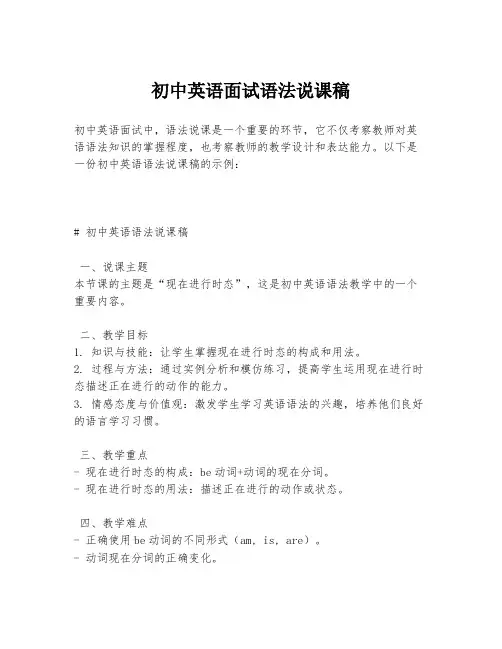
初中英语面试语法说课稿初中英语面试中,语法说课是一个重要的环节,它不仅考察教师对英语语法知识的掌握程度,也考察教师的教学设计和表达能力。
以下是一份初中英语语法说课稿的示例:# 初中英语语法说课稿一、说课主题本节课的主题是“现在进行时态”,这是初中英语语法教学中的一个重要内容。
二、教学目标1. 知识与技能:让学生掌握现在进行时态的构成和用法。
2. 过程与方法:通过实例分析和模仿练习,提高学生运用现在进行时态描述正在进行的动作的能力。
3. 情感态度与价值观:激发学生学习英语语法的兴趣,培养他们良好的语言学习习惯。
三、教学重点- 现在进行时态的构成:be动词+动词的现在分词。
- 现在进行时态的用法:描述正在进行的动作或状态。
四、教学难点- 正确使用be动词的不同形式(am, is, are)。
- 动词现在分词的正确变化。
五、教学方法1. 直观教学法:通过图片和动作展示,帮助学生直观理解现在进行时态。
2. 任务型教学法:设计相关任务,让学生在完成任务的过程中学习和使用现在进行时态。
3. 互动教学法:通过小组讨论和角色扮演,增强学生的互动和实践机会。
六、教学过程1. 导入(Lead-in):展示一些正在进行的动作的图片,引导学生讨论这些动作。
2. 呈现(Presentation):介绍现在进行时态的构成和用法,并通过例句进行说明。
3. 练习(Practice):让学生模仿例句,构造自己的句子,并进行小组交流。
4. 应用(Application):设计情景对话或角色扮演,让学生在实际语境中运用现在进行时态。
5. 总结(Summary):回顾现在进行时态的要点,并强调其在实际交流中的重要性。
6. 作业(Homework):布置相关练习,要求学生描述自己或家人正在进行的活动。
七、教学反思在课后,我会反思本节课的教学效果,考虑学生的反应和理解程度,以便调整教学方法和策略,更好地满足学生的学习需求。
此说课稿仅为示例,实际教学中应根据学生的具体情况和教学环境进行适当调整。
初中英语语法说课稿模板尊敬的各位老师,大家好。
今天我将为大家说课,主题是初中英语语法教学。
本节课我们将重点探讨如何有效地教授和学习英语语法。
一、教学目标本节课的教学目标是让学生掌握现在进行时态的构成和用法,能够正确地使用现在进行时描述正在进行的动作或状态。
二、教学重点1. 现在进行时态的构成:be动词+动词的现在分词形式。
2. 不同人称的be动词形式:I用am,you用are,he/she/it用is,we/they用are。
3. 动词现在分词的构成方法:一般动词后加-ing。
三、教学难点1. 正确区分现在进行时态和其他时态,如一般现在时和一般过去时。
2. 动词现在分词的不规则变化。
四、教学方法1. 引导式教学:通过提问引导学生思考,激发学生学习兴趣。
2. 互动式教学:通过小组讨论和角色扮演,让学生在实际语境中运用语法知识。
3. 练习式教学:通过大量的练习题,巩固学生的语法知识。
五、教学过程1. 导入(Lead-in):通过展示图片或视频,引出现在进行时态的概念。
2. 新课呈现(Presentation):介绍现在进行时态的构成和用法,并通过例句进行展示。
3. 练习(Practice):设计不同类型的练习题,让学生在练习中掌握语法点。
4. 应用(Application):通过角色扮演或情景对话,让学生在实际语境中运用现在进行时态。
5. 总结(Summary):回顾本节课的语法点,强调重点和难点。
六、作业布置1. 完成课后练习题,巩固现在进行时态的用法。
2. 准备一个关于自己正在做的事情的简短口头报告,下节课进行分享。
七、教学反思在教学过程中,要注意观察学生的反馈,及时调整教学方法,确保每个学生都能跟上课程进度。
同时,要鼓励学生多问问题,培养他们的批判性思维能力。
通过本节课的学习,学生将能够更深入地理解现在进行时态,并能够在实际交流中灵活运用。
谢谢大家的聆听,期待与大家共同探讨更多的教学方法。
完整版)初中英语说课稿(英文版)XXX。
students will XXX XXX.2)技能目标skill objectsXXX' ability to discover。
analyze。
and solve problems。
as well as improve their four language skills。
with a special emphasis on reading。
Students will learn to use Top-down model or Bottom-up model to XXX.3)情感态度目标affective objectsXXX' awareness of environmental issues and XXX them to take n to XXX.二、说教法Teaching methods1.任务型教学task-based teachingThe lesson will be taught using a task-based approach。
where students will be given a task to XXX/reading。
This will help them to apply the language XXX real-XXX.2.交互式教学XXXInteractive teaching methods will be used to XXX group ns。
role-plays。
and XXX.3.多媒体辅助教学multimedia-assisted teachingMultimedia tools such as videos。
pictures。
and online resources will be used to enhance students' understanding of the topic and engage their interest。
初中英语教学说课稿(通用5篇)学校英语教学说课稿(精选篇2)一、教材分析本单元的核心教学项目是“谈论现在的状况”(Talking about the present),整个教学内容主要围绕“正在干什么”这个话题绽开,以此为语言背景,让同学通过4个课时的学习感知,初步把握本单元的语法项目--现在进行时的用法。
本单元的一个突出特点是:功能项目与语法项目是的统一的。
功能项目是用现在进行时来描述,它的语法项目是以功能项目为依托的。
前一单元的学习运用Can情态动词时,同学复习把握了大量的动词词汇为本单元同学把握进行时打下了良好的基础。
本课是本单元的第四课,它是本单元的复习课没有新的语法要点。
但它通过问答,对话表演及阅读等活动,巩固同学运用现在进行时表达实际需要的技能,换句话说,本课虽然是复习课,但我认为编者的意图不仅仅是让我们把它定位在复习巩固的要求上,而是盼望通过这一课,使同学能把本单元的功能项目与语法项目达到真正的统一,从而达到学以至用,培育用英语进行交际的力量。
在运用英语的过程中把握英语。
二、依据教材的前后联系和意图以及英语课程标准的要求,我认为本课的教学目标是:1、语言学问:把握单词Wear及Clear把握句型:I’m wearing…运用现在进行时。
2、语言技能:培育听说读写力量,尤其是说的力量,能与他人沟通信息,合作完成任务,并能运用现在进行时独立表达个人思想观点,为将来的写作打下良好的基础。
3、情感态度:通过一系列好玩的活动与任务,激发并强化同学的学习爱好,引导他们渐渐将爱好转化为稳定的学习动机,在教学中给以大量的信息沟,让同学产生剧烈的学习愿望,乐观主动地真实地投入到学习中去。
4、学习策略:通过任务型的教学,让同学学会自主学习,归纳总结,培育主动学习的力量。
尤其对所学内容能主动复习并加以整理和归纳的力量。
5、文化意识:通过一些国外校内生活的图片来了解外国同学的生活。
开拓同学的视野,并加以对比,从而培育同学的跨文化意识。
初中英语语法教案说课稿一、教学目标本节课的教学目标是让学生掌握一般现在时态的构成和用法,能够正确使用一般现在时态描述日常活动和习惯。
同时,培养学生的观察力和分析能力,通过实际语境中的练习,提高学生的语言运用能力。
二、教学重点1. 一般现在时态的构成:主语+动词原形/第三人称单数形式。
2. 一般现在时态的用法:描述客观事实、普遍真理、日常习惯和日常活动。
三、教学难点1. 动词第三人称单数形式的变化规则。
2. 区分一般现在时态与其他时态(如现在进行时)的用法。
四、教学方法1. 直观教学法:通过图片、动作等直观手段,帮助学生理解一般现在时态的用法。
2. 对比教学法:将一般现在时态与其他时态进行对比,加深学生对时态区别的理解。
3. 情景模拟法:创设实际语境,让学生在模拟情景中运用一般现在时态。
五、教学过程1. 导入(5分钟)- 通过展示一系列日常生活图片,引导学生描述图片中的人物正在进行的活动,自然引入一般现在时态的概念。
2. 新课呈现(15分钟)- 明确一般现在时态的定义和构成,通过例句展示一般现在时态的用法。
- 讲解动词第三人称单数形式的变化规则,并给出相应的练习。
3. 练习巩固(15分钟)- 分组进行角色扮演,每组学生根据给定的情景,使用一般现在时态进行对话。
- 教师巡视指导,及时纠正学生的错误。
4. 拓展提高(10分钟)- 通过填空、改错等形式,让学生进一步巩固一般现在时态的用法。
- 引导学生思考一般现在时态在不同语境下的应用。
5. 课堂小结(5分钟)- 总结一般现在时态的构成和用法,强调动词第三人称单数形式的重要性。
- 鼓励学生在日常生活中多观察、多思考,提高英语实际运用能力。
六、作业布置- 完成课后练习题,包括填空、改错和翻译句子。
- 准备一个简短的自我介绍,使用一般现在时态描述自己的日常活动。
七、教学反思在课后,教师应反思本节课的教学效果,考虑学生的理解程度和参与度,以及教学方法是否有效。
教师资格初中英语语法说课稿范文一、教学目标1. 知识与能力目标•熟练掌握初中英语基础语法知识,能够准确运用于语言表达中;•能够正确理解和解析句子结构,准确运用语法规则进行分析和判断;•能够运用语法知识纠正学生在英语学习中常见的语法错误。
2. 过程与方法目标•通过讲解、示范和练习相结合的教学方法,激发学生的学习兴趣;•注重培养学生的语法分析能力和运用能力,提高学生的语言表达能力;•给予学生足够的练习机会,培养学生良好的语法习惯和写作习惯。
3. 情感态度与价值观目标•培养学生良好的语言习惯和语法意识,提高自己的英语学习水平;•培养学生对英语语法的兴趣和积极参与课堂讨论的意愿;•培养学生合作学习的意识和团队精神,增强相互交流和合作的能力。
二、教学重点与难点1. 教学重点•初中英语基础语法知识的讲解和掌握;•英语语法知识与实际语言运用的联系和应用。
2. 教学难点•帮助学生理解句子结构和语法规则之间的关系;•解析语法错误并提供正确的修正方法。
三、教学过程1. 导入•利用一个有关日常生活的实例引入,例如:My brother has a dog. He loves it very much.(我弟弟有一只狗,他非常喜欢它。
)然后问学生这个句子中有什么语法错误。
2. 讲解与示范•通过讲解句子结构、语法规则和语法术语,如主语、谓语、宾语、定语等,帮助学生理解句子的基本构成。
•示范一些常见的语法错误,并解释其原因和修正方法。
3. 练习与合作•给学生发放练习册,让学生自主完成一些基础练习题,如填空、改错等,检查他们对所学知识的掌握程度。
•将学生分成小组,进行合作学习。
每个小组选择一个语法知识点,让他们编写几个练习题,然后相互交换并进行解答。
4. 总结与展示•请学生汇报组内编写的练习题,并给予评价和指导。
•对本节课所学的语法知识进行总结,并与实际语言运用进行关联,说明学习语法的重要性和必要性。
四、课堂展示通过本节课的讲解和练习,学生能够准确理解和运用初中英语的基础语法知识,能够正确分析句子结构和判断语法错误。
初中英语语法说课稿(大全五篇)第一篇:初中英语语法说课稿Good afternoon, everyone.I’m Zhou Yan.I’m an English teacher from Experimental School of Suqian.Now I’ll say Sample A of Lesson Six in Book One.I’ll prepare to say the lesson from four parts.Part One Analysis of the T eaching Material(一)STATUS AND FUNCTION1.This is an important lesson in Book One.From this lesson, it starts asking the Ss to grasp contents of each Sample.T o attain “four skills” request of listening, speaking, reading and writing.T o start listing “Word Bank” and tell the Ss to remember the new words.To start asking the Ss to write English sentences well.Therefore this lesson is in the important position of the teaching material.2.This lesson is the first one of Unit 2.So if the Ss can learn it well, it will be helpful to make the Ss learn the rest of this unit.3.Such a topic is related to daily life, so it is helpful to raise learning interests of students and it will be also helpful to improve their spoken English.(二)ANALYSIS OF THE STUDENTS The Ss has learned English for about one month so far.They can understand some words and some simple sentences.The Ss have taken a great interest in English now.(三)TEACHING AIMS AND DEMANDSThe teaching aim's basis is established according to Junior School English syllabus' provision.1.Knowledge objects(1)To make the Ss know how to use the affirmative sentence “This is....” and the negative sentence “This is not….”Everyday expressions for “Apologies”“I'm sorry”“That's all right”.(2)To study the new words “six, hey, sorry, it’s, that’s”, etc.by learning the dialogue of this lesson.(3)To finish someexercises.2.Ability objects(1)To develop the Ss’ abilities of listening, speaking, reading and writing.(2)To train the Ss’ ability of working in pairs.(3)To develop the Ss’ abilities of communication by learning the useful structures.3.Moral objects(1)To enable the Ss to be polite and love life.(2)To enable the Ss to look after their things well.(四)TEACHING KEY AND DIFFICULT POINTSThe teaching key and difficult points’ basis is established according to Sample A of Lesson Six in the teaching material's position and function.1.Key points:(1).To help the Ss to communicate with each other.(2).To enable the Ss to study in groups and co-operate skillfully.(3).T o develop the Ss’ interest in English.2.Difficult points:(1)How to make dialogues and act them out.(2)How to write the right whole sentences.(五)TEACHING AIDSMulti-media computer, Tape recorder, Software: Powerpoint or Authorware, school things and so on.They will be needed in this lesson.Part Two The T eaching Methods municative teaching method 2.Audio-visual teaching method 3.Task-based” teaching methodAs we all know: the main instructional aims of learning English in the Middle School is to cultivate students’ abilities of listening, speaking, reading, writing and their good sense of the English language.So in this lesson I’ll mainly use “Communicative” teaching method, “Audio-visual” teaching method an d “Task-based” teaching method.That is to say, I’ll let the Ss to get a better understanding of the key structure of the dialogue.I’ll give the Ss some tasks and arrange five kinds of activities: talking, guessing games, watching CAI, acting outSample A and having a competition.T eaching special features To use these methods are helpful to develop the Ss’ thought.Part Three STUDYING WAYS1.Teach the Ss how to be successful language learners.2.Let the Ss pass “Observation—Imitation—Practice ” to study language.3.Teach the Ss how to master dialogues and how to communicate with others.Teaching special features:Let the Ss communicate with each other and adopt competition methods to develop the Ss’ keen interest in English.Part Four T eaching ProcedureI’ll finish this lesson in four steps.First I’ll divide the Ss into four groups and bring a competition into the class.At last let’s see which group is the winner.Step1 Warm-up1.Free talk between T and Ss.Such as: Hi, I’m....What’s your name? This is ….How do you do? Who is he/she? How are you? Who can count from 1to 5? What’s this in English? etc.2.A game: Ask the Ss to give T some school things.For example: T: Give me your book.(ruler, box, pen, table, knife, etc.)T: This is your book.This is not my book.It’s your book.etc.In this course I’ll ask them to make a dialogue group by group without repetition.Find out which group will make the most dialogues.Purpose of my designing: I think it is important to form a better English learning surrounding for the Ss by imitating and at the same time it is necessary to provide situations to review learned knowledge.Step2.PresentationThis course is very important.I’ll mainly talk about this step.I’ll use CAI to present the whole dialogue.Arrange some situations to help Ss understand Sample A.First scene: There is a bag on the floor.B is picking it up and get ready to leave.Now A is talking with B.A: Hi, B.How are you today? B: I’m fine, thankyou.And you? A: I’m fine, too.Oh, this is my bag.B: No, this is not your bag.It’s my bag.A:(Look closely)Oh, I’m sorry.B: That’s all right.(At the same time, C is running up and hitting A.)C: Oh, I’m sorry.A: That’s OK.I’ll write the key points on the Bb while they are watching.After watching, I’ll teach them to read the words and sentences on the Bb.Make sure they can read them well.Purpose of my designing: T o present Sample A by CAI is much easier for the Ss to learn and grasp the meanings.CAI can provide a real situation with its sound and picture and it makes the relationships between the Ss better.Step3.Practice First play the tape recorder.Let the Ss listen and imitate the dialogue.Pay attention to their pronunciation and intonation.In this step the Ss are required to practise the Sample in pairs by reading the dialogue aloud.This step is employed to make the Ss grasp the Sample.At last I’ll ask the Ss to think hard and act it out with a partner according to Sample A.Then find out which group will act it out well.I’ll give them red stars.Purpose of my designing: This step is employed to make the Ss get the general idea of the dialogue as a whole one.At the same time let the Ss have a chance to practise their listening and spoken ability.Step4.ProductionIn this step I’ll give the Ss a free space to show their abilities.Second scene: The Ss are having a picnic.It’s hot and they take off their coats and put them together.They are singing and dancing, laughing and chatting.After the picnic, they begin to look for their coats.D and E are talking.F and G are talking.etc.After watching, I’ll give the Ss some tasks to make similar dialogues without repetition and find out which group will make more dialogues.Purpose of my designing: “Task-based” teaching method is used here to develop the Ss’ ability ofcommunication and also their ability of co-operation will be well trained.Tell the Ss we should be polite and take good care of our things.We should love our life.I think proper competition can arouse the Ss’ interest in English learning.If the Ss can finish this task well, they will benefit a lot in their spoken English.2.Skill 1 Model 1.I’ll ask four Ss of the groups to write these sentences on the Bb in the four lines.Then check their handwriting, correct their mistakes.Find out who will write well and whose handing is the best.3.Finish the Ss’ workbook.Purpose of my designing: To check the knowledge Ss have learned in this lesson.Step5.Homework:(1)Recite the words as many as possible after class.(2)Make a dialogue according to Sample A and write it in the exercise book.Purpose of my designing: I think homework is so important that the Ss should speak English as much as they can in class or after class.It is necessary for the Ss to do some extensive exercises after class to consolidate the knowledge they learned.Blackboard DesignLesson Six S ample ASix This is my….hey This is not your....sorry It’s my....Picture it’s=it is Oh, I’m sorry.that’s=that is That’s all right/OK.第二篇:关于初中英语语法的说课稿语法是英语学习总非常重要的内容,关于初中英语语法的说课稿有哪些?以下是小编为您整理的相关资料,欢迎阅读!一、教学目标学习反意疑问句二、教学重点通过教学让学生掌握反意疑问句的基本句型结构和回答。
本文部分内容来自网络整理,本司不为其真实性负责,如有异议或侵权请及时联系,本司将立即删除!
== 本文为word格式,下载后可方便编辑和修改! ==
初中英语语法说课稿
在初中的同学学习语法十分重要,那么应该如何做好相关的说课稿呢?
下面是小编分享给大家的初中英语语法说课稿,希望对大家有帮助。
一、教学目标
学习反意疑问句
二、教学重点
通过教学使学生掌握反意疑问句的基本句型结构和回答。
三、教学难点
1.主句谓语是think, believe, expect, suppose, imagine等引导的宾
语从句,就从句部分提问。
2。
陈述句部分主语是不定代词everybody, anyone, somebody, nobody, no one等,疑问部分常用复数they,有时也用单数he。
教学程序如下:
初二下学期第十单元安排了学习反意疑问句的教学内容,
一、说教学程序:导入——新知识的学习
说设计这个教学程序的基本思路和根据。
就初二学生来说他们学习了以下
语法项目:be动词(包括be 动词的过去时); There be句型;行为动词
的一般现在时;行为动词的一般过去时;一般将来时;(包括There be句型的一般将来时);现在完成时;现在完成进行时;情态动词和祈使句。
因此,我
在讲授反意疑问句时,仅仅围绕学生学过的以上语法项目进行反意疑问句的教
学并进行反复练习。
具体练习作业本(上、下)、典中点中的练习都有,另外,再补充一些总结性的有关反意疑问句的专项练习加以巩固。
二、说练习和作业的设计。
检测训练——总结巩固。
通过做作业本(上、下)中的练习、典中点中的练习进行训练,再补充一些总结性的有关反意疑问句的专项练习进行检测加以巩固。
三、说板书设计:
通过课件展示教学内容(以下各项教学内容)
以下分为十一个部分进行讲解。
反意疑问句
反意疑问句是由两部分组成的,前一部分是对事物的陈述(即陈述句),后一部分是简短的提问(即简短疑问句),中间用逗号隔开。
如果前一部分用肯定句,后一部分就用否定疑问句;如果前一部分用否定句,后一部分就用肯定疑问句。
两部分的人称和时态要一致。
其回答是用yes或no来表示。
一、含be(is, are, was, were)动词的反意疑问句
其句型是:句型1:主语+ be+其它,isn’t(aren’t, wasn’t,
weren’t)+ 主语?
句型2:主语+ be not+其它,is(are, was, were) + 主语?
① You are from America, aren’t you? Yes, I am. No, I’m not.
② It isn’t very cold today, is it? Yes, it is.No, it isn’t.
③ Tom was away yesterday, wasn’t he? Yes, he was. No, he wasn’t.
④ The Green weren’t at home last night, were they?
Yes, they were. No, they weren’t.
⑤ Mary is reading English now, isn’t she? Yes, she is. No, she isn’t.
⑥ Your parents aren’t going to have a party this Sunday, are they?
Yes, they are. No, they aren’t.
⑦ The girls were singing when the teacher came in, weren’t they?
Yes, they were. No, they weren’t.
注意:There be句型
① There is an old picture on the wall, isn’t there?
Yes, there is. No, there isn’t.
② There aren’t any children in the room, are there?
Yes, there are. No, there aren’t.
③ There wasn’t a telephone call for me, was there?
Yes, there was. No, there wasn’t.
④ There were enough people to pick apples, weren’t there?
Yes, there were. No, there weren’t.
二、行为动词的一般现在时的反意疑问句
其句型是:句型1: 主语+动词原形+其它,don’t I(you, we, they)?
句型2: 主语+ don’t+动词原形+其它,do I(you, we, they)?
句型3: 主语+动词第三人称单数+其它,doesn’t he(she, it)?
句型4: 主语+ doesn’t+动词原形+其它,does he(she, it)?
① You often watch TV in the evening, don’t you? Yes, I do. No,
I don’t.
② The students don’t study hard, do they? Yes, they do. No,
they don’t.
③ Mary studies Chinese hard, doesn’t she? Yes, she does. No,
she doesn’t.
④ The boy doesn’t often go to school by bike, does he?
Yes, he does. No, he doesn’t.
⑤ The first class begins at eight, doesn’t it? Yes, it does. No, it doesn’t.
三、行为动词的一般过去时的反意疑问句。